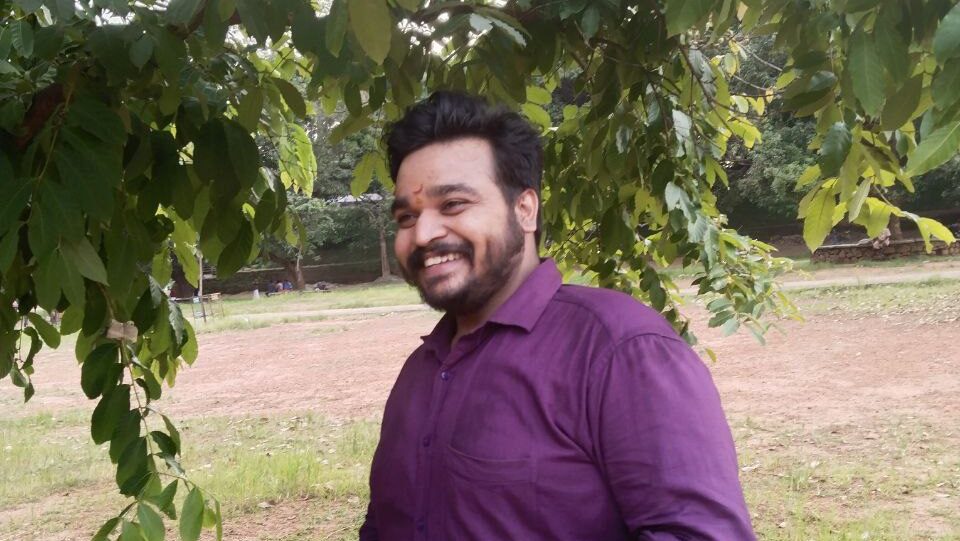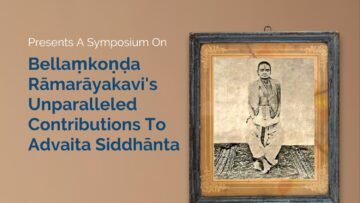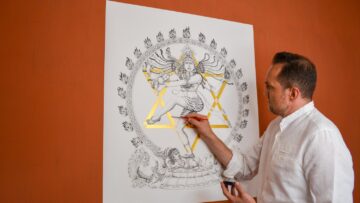Abhijith Sreekumar pursued his BSc in Chemistry along with his training in Sanskrit Shastras under the grace of his guru, the great scholar Prof Chinthalapati Satyanarayana Sastrikal at Kalady. For the young student, it is his guru’s grace has taken him far to find the roots of his traditions. He later worked at the IKS division of IIT Madras before going abroad to pursue his higher studies.
Abhijith is currently pursuing his studies at the Centre for the Studies for Manuscript Cultures at Universitat Hamburg, Germany. He’s working with Prof Harunaga Issacson, Director, Centre for Tantric Studies, Universitat Hamburg, on the critical edition of unpublished Manuscripts of Tantric Texts. They will work initially on the texts related to the Tara traditions.
He will also be working on translating some Sanskrit Manuscripts on technical and scientific literature. Just a while ago, he has procured an ancient manuscript on Dhanurveda from Cambridge University and is working on it for his Phd proposal.
Abhijith presented a paper – Tārā Sadhana: A Universal Archetype – at the Indica conference on Tantra and Tantric Traditions.
What inspired you to join the IKS division of IIT Madras? What are the projects that inspire you?
From my early childhood, I was groomed into the vast potential of our Sastras and Sanskrit, thanks to my teachers and the auspices of my school, BHSS Kalady. The atmosphere at the ashram (it was the name of the school) played a major role in cultivating my interest in the scientific heritage of our land. Initially, my interest was in Chemistry, specifically Indian Alchemy. I wanted to validate the procedures and inventions in our texts like Rasarvana, Rasasamuchaya, Agastyasamhita, etc. During my graduation in Chemistry, I found a lot of like-minded friends and eminent mentors in Samskritha Bharathy and at the Sanskrit Department in Sree Sankara College Kalady. From these sources, I happened to know about the works in the field of IKS in IITs.
I was preparing for the JAM exam to get into the Integrated Ph.D. programme in Chemistry at IIT. During that period, I saw the advertised project associate post at the Centre for Indian Knowledge Systems, IIT Madras. The moments before the online interview were among the most tense and nervous moments in my life. I hadn’t read the scheduled mail for the interview as it went to the spam folder. At the time of my interview, Prof. Aditya called me, asking if I was not attending the interview. He told me, “If you are interested, then get ready for the interview in 15 minutes.” At that time, I was nervous, standing in the queue for darshan at Kollur Mookambika temple with my friends. I somehow came out from the inner sanctum just 5 minutes before the interview. I quickly searched for a less crowded place inside the temple with enough signal coverage for a video meeting. Throughout the interview, I was nervous, wondering if someone would ring the bells at the temple or play musical instruments.
By her grace, the interview went well, and Prof. Aditya took me into the center. At the center, I was mainly working on reading a mathematical manuscript in Sanskrit, which was written in an early Malayalam script. The thematic areas at the center are widespread and multidisciplinary, including Ancient Indian Architecture, Economics, Indian Aesthetics, Linguistic Studies, Indian Mathematics, and Astronomy. The centre made my roots stronger and even gave me enough insights into the necessity of young scholars to enter into this field, thanks to Prof. Jyotirmaya Tripati, Prof. Aditya Kolachana, Prof. Rajesh Kumar other Faculties, and my colleagues. IKS Centre at IIT Madras is a nurturing ground for all those young minds who are enthusiastic about the Indigenous Knowledge Systems spanning across all the fields of Knowledge not just technical Literature.
What role are IITs playing at the national level to preserve our traditions, especially Chennai, Kharaghpur, and Gandhinagar?
One of the myths of Western historiography, as well as its derivative discourses in Indian academia, was that India (that is Bharat) may have an intellectual tradition but lacks a significant technological/scientific temper. It fit well into the idea of Indians being inward-looking and interested in personal salvation rather than social emancipation, etc.
IKS centers are changing all that. The fact of the matter is that India had highly evolved and sophisticated ways of understanding the world that existed both inside and outside of human consciousness. Traditionally confined to humanities departments of universities, IKS lived with conventional approaches. The knowledge texts of India remained just texts for analysis and interpretation. Universities rarely had the technological expertise to convert ancient wisdom into products, services, or formulas. IITs are making a concrete difference in that respect. Such IKS centers draw expertise from multiple domains and see how modern and contemporary IKS could be. IITs can try various building methods, alchemy, medicine, etc., in labs and through experiments and can make a compelling case for IKS.
IIT Gandhinagar is the pioneer center for IKS in IITs. The earlier works were mainly focused on Mathematical traditions. Currently, IIT Gandhinagar is running a semester course on Introduction to Indian Knowledge Systems (IKS) with a view to exploring India’s intellectual, scientific, and artistic knowledge traditions. The lineage starting from IITG propagates to IIT B after establishing a deeper sense of understanding in academia about the Bharathiya Jnana Parampara. The lineage has now spread its branches to IITKGP, IITM, IISCER Pune, and it’s likely that the lineage will spread across the land through energetic young minds.
IITB operates a Cell for Indian Science and Technology in Sanskrit (CISTS). Milestone works in Indian Astronomy and Mathematics have been produced from the center. The Center has been inspiring a new generation of thousands of students, scholars, and faculties to undertake research on the riches of India’s scientific Heritage. CISTS is a multidisciplinary Knowledge hub able to make an impact with a powerful combination of Science, Sanskrit, and Spirituality.
IITKgp focuses on research areas like Literature, Translation, Philosophy of Language, Positive Psychology, Psycholinguistics and Sociolinguistics, Sanskrit Grammar, Manuscript studies, Science of Happiness, Scientific Lit. in Sanskrit, Astronomy, and Mathematics, Yoga, Patañjali Yoga Sutra, etc
Centre For Indian Knowledge Systems at IIT Madras was established recently in August 2022, with the support from IKS division of AICTE under the Ministry of Education. Currently, the main thematic areas are Astronomy and mathematics, Indian Aesthetics, Panini and the Foundations of Language, Indian Linguistics, Dravidian Temple Architecture and building methods, Economics, and Music.
As I said, the lineages and its branches are spreading. It may be added that this knowledge is not just tradition in a fossilized sense. The reality is that they are living traditions and are continuously evolving, though it had stagnated for some centuries. IITs and their faculty can make that knowledge count and substantively establish that they belong to the present and future.
India has made great contributions in the fields of Mathematics and Chemistry, which are your stated areas of interest. How do you think India is slowly coming out of a sense of inferiority in these fields, and how do we again become superpowers in these areas?
First of all, we didn’t have any inferiority in reality. For decades, we had forgotten that we were the custodians of immense knowledge and wisdom. Our Sastras are much more advanced and sophisticated, and approaching them just through the Western methodology is not advisable. Whether it is Rasayana, Ganita, Astrology, Vastu, Ayurveda, or Yoga, each branch has its own methodology. Omitting these methodologies and blindly trying to infuse them with the Western methodology will not lead to any advancements. Recently, US scientists gave feedback appreciating the mathematical excellence of Madhava of Sangama Grama, a celebrated figure in the Kerala school of mathematics. We were eager to share the news and be proud of ourselves. So many works have been happening in Madhava and the Kerala School of Mathematics for years in our land, and we don’t value them unless told by Westerners. Someone else has to remind you what is there inside your own house. Changing the mindsets of our society and academia is the key to becoming a superpower, and this applies to all fields. To be specific in the field of mathematics, the texts are mostly in Sanskrit or Malayalam or a mixture of these two languages (Manipravalam). For Rasa Sastra (Chemistry), Sanskrit texts of Nagarjuna and Agasthyamuni, along with other Siddha’s works in Tamil, are the primary sources. Along with natural sciences, children must be equipped with knowledge of the indigenous language and culture as well.
From my limited knowledge and experience, I feel this part to be the most difficult and hectic. I recall from my childhood a time in Kerala when parents were proud to say, “Our children don’t know Malayalam.” I even had to face criticism, including from teachers and family, for spending my time and effort in Sanskrit. Our society is ignorant of our potential, and this is where the role of the IKS mission is essential – to help people realize our own forgotten intellectual, technological, and cultural advancements. Winds are changing now, more and more young minds are entering this field of Indic Knowledge systems, and they are also getting systemic support. If this pace continues, we will likely get many more Ramanujans and JC Boses in the future.
What aspect of Shakta worship have you researched? Was it from a personal or professional point of view?
My academic research was mostly in Dakshinachara and Vamacara. I’ve never thought about making these vidyas into a profession. It was mostly for quenching my thirst for philosophical aspects and somewhat the practical sides as well. Later on, it took my interest in Vajrayana (Tantric Buddhism) as well. The sole interest was personal, or rather the passion or curiosity to dig into the esoteric mysteries in our land, which in turn gave me enough acceleration in my career as well.
Mathematics, especially geometry, is of great importance in our Yantras. What value do these kinds of esoteric practices have for science in general?
The word Tantra it self gives the meaning. Etymologically the word is तनु विस्तारे , तनोति तन्यते इति वा तन्त्रम् one which spreads/ manifests. It enables the inner potential within one to do great deeds. Quoting the words of Swami Vivekananda, “Education is the Manifestation of the perfection already in man“. These practices rather to be called as Sadhana manifests one true nature and potential through intellectual and practical activities encompassing the systematic study of the structure and behaviour of ones own consciousness through observation and experiments within our selves. Vidya is of two types Parā and Aparā. Parā makes us dwell in to the depth of consciousness, while Aparā equips us with the weaponry to unleash and channelize this consciousness ie; unbiased way of thinking, seeing and observing the outer world or rather the physical world. Recall the definition of the word science: (knowledge from) the careful study of the structure and behaviour of the physical world, especially by watching, measuring, and doing experiments, and the development of theories to describe the results of these activities.(Source: Cambridge Dictionary).
A few examples can help make this clear. How was Kalidasa able to state the changes of human mind with the changes in climate? How did he identify the structure of clouds and sky at that time? The mercury lingams across India are still a question to modern science? While Mercury (Hg) is a banned toxin across the globe, our Sastras were so advanced that it saw that the toxin was a potential medicine. It’s not a joke or a mere fantasy, there are physicians in clinics in India even today, who cure patients successfully. Due to the blind obedience towards western methodology, these knowledge sources have been repeatedly neglected.
Nagarjuna, the Great Alchemist, has elaborated on the ritualistic practices of worship of Devi Rasaruchika and successfully transformed them into these texts. All these practices are in a highly advanced realm of science that requires true loyalty and perseverance to be a master of. Recalling the famous quote of Nicolas Tesla: “if you want to find the secrets of the universe, think in terms of energy, frequency and vibration.” Our ancestors have termed this idea as Spanda. In my opinion, I would like to believe that Nicolas Tesla too was a Sadhaka. It is just my personal opinion, and I don’t have any evidence for it. Mantras are a much more sophisticated, practical approach to this philosophy espoused by Tesla. The rules of pronunciation and rhythm of mantras are governed by strict rules and regulations. To sum up, I quote a statement by the great Mathematician Srinivasa Ramanujan- “My Devi bleeds mathematics”.
What is your main perspective in your talk on Tara as an archetype of the Divine Feminine?
In discussing Tārā as an archetype of the Divine Feminine, the central perspective is to explore the multifaceted and transcultural significance of Tārā as a symbol of feminine divinity and the method of her worship called Cinachara. Tārā represents compassion, wisdom, and liberation, transcending religious and cultural boundaries. Her role in guiding beings across the cycle of suffering (Samsara) aligns with the broader theme of the Divine Feminine as a source of nurturing, compassion, and spiritual awakening. In Buddhism, Tara is detailed as the consort of Avalokitesvara. She is the embodiment of love and compassion and is considered the mother of all Buddhas. Twenty-one forms of Tara are elaborated in the Suryagupta lineage in Buddhism. In Bharat, Tara Devi is worshipped mainly in three forms, namely Ugratara, Ekajata, and Nilasaraswathy. Tarakasura had worshipped Ugratara to gain power, and Brahmadev invoked Nilasaraswathy to start the creation. Like these, Tārā’s story resonates with various traditions, both in India and Tibet, highlighting her timeless and universal relevance. There are no strict rules or regulations in Tara sadhana; the ultimate purpose is to purify one’s soul. In reaching the goals, one will lose a lot, including egos, agony, grief. This perspective underscores the idea that Tārā serves as a profound archetype that transcends religious frameworks and offers a path toward inner transformation and realization through compassion and wisdom. These extreme esoteric practices should be only performed by those who are worthy of it. And in Tantra, you may not go in search of your Guru, when one is worthy and mature enough for it, The Guru himself comes to you. Just a reminder for the readers who are curious about these esoteric practices: It takes great valor to purify your mind, so Tara’s path is not for the faint-hearted.







